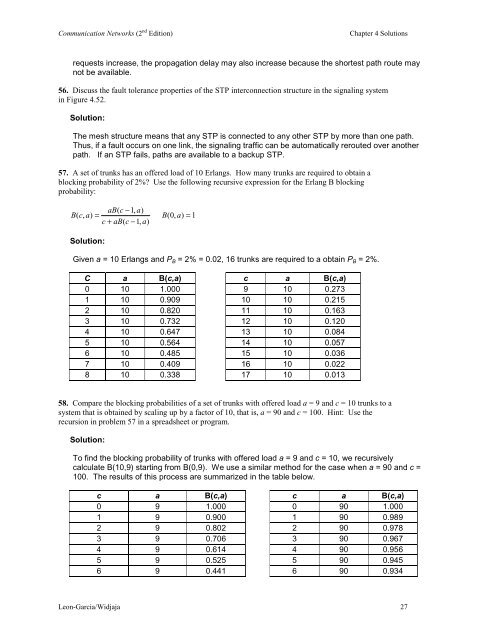Solutions to Chapter 4 - Communication Networks
Solutions to Chapter 4 - Communication Networks
Solutions to Chapter 4 - Communication Networks
Create successful ePaper yourself
Turn your PDF publications into a flip-book with our unique Google optimized e-Paper software.
<strong>Communication</strong> <strong>Networks</strong> (2 nd Edition)<br />
<strong>Chapter</strong> 4 <strong>Solutions</strong><br />
requests increase, the propagation delay may also increase because the shortest path route may<br />
not be available.<br />
56. Discuss the fault <strong>to</strong>lerance properties of the STP interconnection structure in the signaling system<br />
in Figure 4.52.<br />
Solution:<br />
The mesh structure means that any STP is connected <strong>to</strong> any other STP by more than one path.<br />
Thus, if a fault occurs on one link, the signaling traffic can be au<strong>to</strong>matically rerouted over another<br />
path. If an STP fails, paths are available <strong>to</strong> a backup STP.<br />
57. A set of trunks has an offered load of 10 Erlangs. How many trunks are required <strong>to</strong> obtain a<br />
blocking probability of 2% Use the following recursive expression for the Erlang B blocking<br />
probability:<br />
aB(<br />
c −1,<br />
a)<br />
B( c,<br />
a)<br />
= B(0,<br />
a)<br />
= 1<br />
c + aB(<br />
c −1,<br />
a)<br />
Solution:<br />
Given a = 10 Erlangs and P B = 2% = 0.02, 16 trunks are required <strong>to</strong> a obtain P B = 2%.<br />
C a B(c,a) c a B(c,a)<br />
0 10 1.000 9 10 0.273<br />
1 10 0.909 10 10 0.215<br />
2 10 0.820 11 10 0.163<br />
3 10 0.732 12 10 0.120<br />
4 10 0.647 13 10 0.084<br />
5 10 0.564 14 10 0.057<br />
6 10 0.485 15 10 0.036<br />
7 10 0.409 16 10 0.022<br />
8 10 0.338 17 10 0.013<br />
58. Compare the blocking probabilities of a set of trunks with offered load a = 9 and c = 10 trunks <strong>to</strong> a<br />
system that is obtained by scaling up by a fac<strong>to</strong>r of 10, that is, a = 90 and c = 100. Hint: Use the<br />
recursion in problem 57 in a spreadsheet or program.<br />
Solution:<br />
To find the blocking probability of trunks with offered load a = 9 and c = 10, we recursively<br />
calculate B(10,9) starting from B(0,9). We use a similar method for the case when a = 90 and c =<br />
100. The results of this process are summarized in the table below.<br />
c a B(c,a) c a B(c,a)<br />
0 9 1.000 0 90 1.000<br />
1 9 0.900 1 90 0.989<br />
2 9 0.802 2 90 0.978<br />
3 9 0.706 3 90 0.967<br />
4 9 0.614 4 90 0.956<br />
5 9 0.525 5 90 0.945<br />
6 9 0.441 6 90 0.934<br />
Leon-Garcia/Widjaja 27







